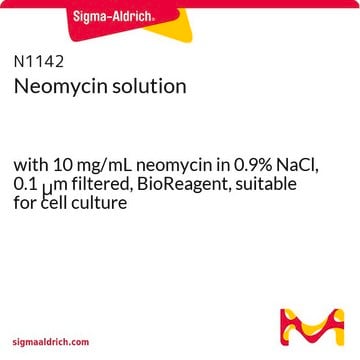Products may be shipped at a different temperature than the recommended long-term storage temperature. If the product quality is sensitive to short-term exposure to conditions other than the recommended long-term storage, it will be shipped on wet or dry-ice. If the product quality is NOT affected by short-term exposure to conditions other than the recommended long-term storage, it will be shipped at ambient temperature. As shipping routes are configured for minimum transit times, shipping at ambient temperature helps control shipping costs for our customers. For more information, please refer to the Storage and Transport Conditions document: https://www.sigmaaldrich.com/deepweb/assets/sigmaaldrich/marketing/global/documents/316/622/storage-transport-conditions-mk.pdf
SBR00022
Blasticidin S Ready Made Solution
10 mg/mL (20 mM HEPES), 0.22 μm filtered
Sélectionner une taille de conditionnement
Sélectionner une taille de conditionnement
About This Item
Produits recommandés
Niveau de qualité
Stérilité
0.22 μm filtered
Essai
≥98% (HPLC)
Forme
liquid
Concentration
10 mg/mL (20 mM HEPES)
Couleur
colorless to faint yellow
Spectre d'activité de l'antibiotique
fungi
Mode d’action
protein synthesis | interferes
Température de stockage
−20°C
Chaîne SMILES
CN(CCC(CC(=O)NC1C=CC(OC1C(=O)O)N2C=CC(=NC2=O)N)N)C(=N)N.Cl
InChI
1S/C17H26N8O5.ClH/c1-24(16(20)21)6-4-9(18)8-12(26)22-10-2-3-13(30-14(10)15(27)28)25-7-5-11(19)23-17(25)29;/h2-3,5,7,9-10,13-14H,4,6,8,18H2,1H3,(H3,20,21)(H,22,26)(H,27,28)(H2,19,23,29);1H
Clé InChI
YQXYQOXRCNEATG-UHFFFAOYSA-N
Catégories apparentées
Description générale
In research, Blasticidin S has become a valuable tool, notably as a marker for strain manipulations. Recent applications involve the use of Blasticidin S as a selection agent for cells carrying plasmids conferring blasticidin resistance. The resistance is mediated by the blasticidin S deaminase genes (bsr from Bacillus cereus or BSD from Aspergillus terreus). These genes produce enzymes that catalyze the hydrolytic deamination of the cytosine moiety in blasticidin S, leading to the formation of a non-toxic deaminohydroxy derivative. This resistance mechanism is crucial in various studies involving genetic manipulations and selections in cell biology and biochemical research.
Application
- studies to have fungicidal properties and prevents rice blast disease.[1]
- used as a selection agent for transformed cells that contain the resistance genes bls, bsr, or bsd. Blasticidin S has been used to select HEK293-T cells with TLR-2 constructs and HEK-D5 cells.[2][3]
- used to study protein synthesis at the level of peptide bond formation.
Actions biochimiques/physiologiques
Antimicrobial Spectrum: Active against mycobacteria, several Gram-positive and Gram-negative bacteria
Caractéristiques et avantages
- High-quality antibiotic suitable for multiple research applications
- Ideal for Cell Biology and Biochemical research
Autres remarques
Mention d'avertissement
Danger
Mentions de danger
Conseils de prudence
Classification des risques
Acute Tox. 3 Oral
Code de la classe de stockage
6.1D - Non-combustible acute toxic Cat.3 / toxic hazardous materials or hazardous materials causing chronic effects
Classe de danger pour l'eau (WGK)
WGK 1
Point d'éclair (°F)
Not applicable
Point d'éclair (°C)
Not applicable
Faites votre choix parmi les versions les plus récentes :
Certificats d'analyse (COA)
Vous ne trouvez pas la bonne version ?
Si vous avez besoin d'une version particulière, vous pouvez rechercher un certificat spécifique par le numéro de lot.
Déjà en possession de ce produit ?
Retrouvez la documentation relative aux produits que vous avez récemment achetés dans la Bibliothèque de documents.
Les clients ont également consulté
-
How is shipping temperature determined? And how is it related to the product storage temperature?
1 réponse-
Utile ?
-
-
How can I determine the shelf life / expiration / retest date of this product?
1 réponse-
If this product has an expiration or retest date, it will be shown on the Certificate of Analysis (COA, CofA). If there is no retest or expiration date listed on the product's COA, we do not have suitable stability data to determine a shelf life. For these products, the only date on the COA will be the release date; a retest, expiration, or use-by-date will not be displayed.
For all products, we recommend handling per defined conditions as printed in our product literature and website product descriptions. We recommend that products should be routinely inspected by customers to ensure they perform as expected.
For products without retest or expiration dates, our standard warranty of 1 year from the date of shipment is applicable.
For more information, please refer to the Product Dating Information document: https://www.sigmaaldrich.com/deepweb/assets/sigmaaldrich/marketing/global/documents/449/386/product-dating-information-mk.pdfUtile ?
-
-
Can you please advise the freeze/thaw cycle of this product?
1 réponse-
This product is shipped at ambient temperature and may be stored at 4 °C for up to two weeks. For long term storage, -20 °C is recommended. The solution should be aliquoted prior to freezer storage. Avoid repeated freeze/thaw cycles.
Utile ?
-
Filtres actifs
Notre équipe de scientifiques dispose d'une expérience dans tous les secteurs de la recherche, notamment en sciences de la vie, science des matériaux, synthèse chimique, chromatographie, analyse et dans de nombreux autres domaines..
Contacter notre Service technique









